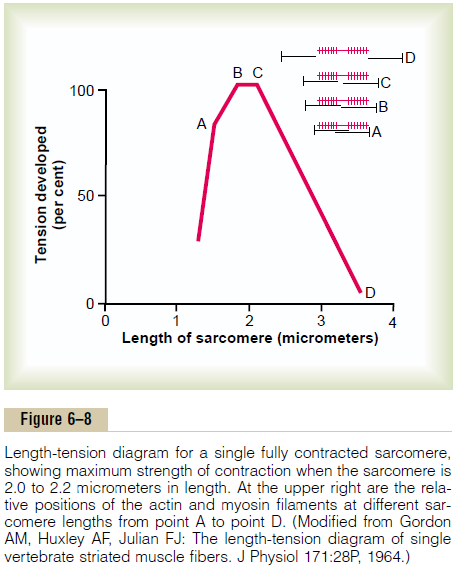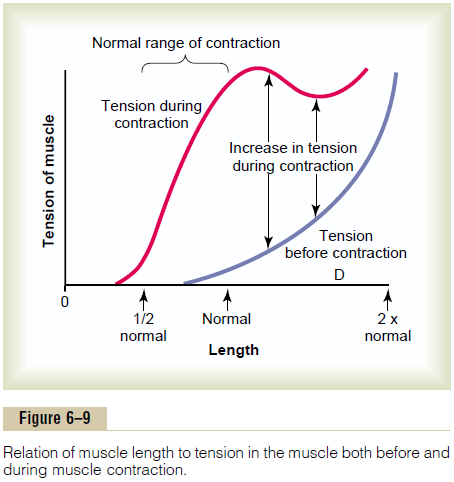Chapter: Medical Physiology: Membrane Physiology, Nerve, and Muscle : Contraction of Skeletal Muscle
Effect of Amount of Actin and Myosin Filament Overlap on Tension Developed by the Contracting Muscle
Effect of Amount of Actin and Myosin Filament Overlap on Tension Developed by the Contracting Muscle
Figure 6–8 shows the effect of sarcomere length and amount of myosin-actin filament overlap on the active tension developed by a contracting muscle fiber.To the right, shown in black, are different degrees of overlap of the myosin and actin filaments at different sarco-mere lengths. At point D on the diagram, the actin filament has pulled all the way out to the end of the myosin filament, with no actin-myosin overlap. At this point, the tension developed by the activated muscle is zero. Then, as the sarcomere shortens and the actin filament begins to overlap the myosin filament, the tension increases progressively until the sarcomere length decreases to about 2.2 micrometers. At this point, the actin filament has already overlapped all the cross-bridges of the myosin filament but has not yet reached the center of the myosin filament. With

further shortening, the sarcomere maintains full tension until point B is reached, at a sarcomere length of about 2 micrometers. At this point, the ends of the two actin filaments begin to overlap each other in addition to overlapping the myosin filaments. As the sarcomere length falls from 2 micrometers down to about 1.65 micrometers, at point A, the strength of contraction decreases rapidly. At this point, the two Z discs of the sarcomere abut the ends of the myosin fil-aments. Then, as contraction proceeds to still shorter sarcomere lengths, the ends of the myosin filaments are crumpled and, as shown in the figure, the strength of contraction approaches zero, but the entire muscle has now contracted to its shortest length.
Effect of Muscle Length on Force of Contraction in the Whole Intact Muscle. The top curve of Figure 6–9 is similar tothat in Figure 6–8, but the curve in Figure 6–9 depicts tension of the intact, whole muscle rather than of a single muscle fiber. The whole muscle has a large amount of connective tissue in it; also, the sarcomeres in different parts of the muscle do not always contract the same amount. Therefore, the curve has somewhat different dimensions from those shown for the individual muscle fiber, but it exhibits the same general form for the slope in the normal range of contraction, as noted in Figure 6–9.

Note in Figure 6–9 that when the muscle is at its normal resting length, which is at a sarcomere length of about 2 micrometers, it contracts upon activation with the approximate maximum force of contraction.
However, the increase in tension that occurs during contraction, called active tension, decreases as the muscle is stretched beyond its normal length—that is, to a sarcomere length greater than about 2.2 microm-eters. This is demonstrated by the decreased length of the arrow in the figure at greater than normal muscle length.
Related Topics